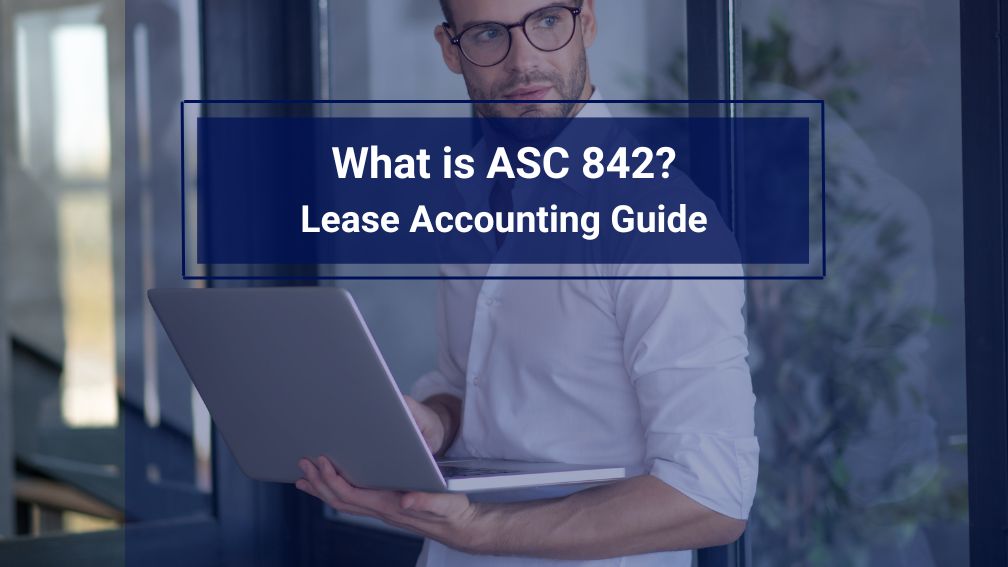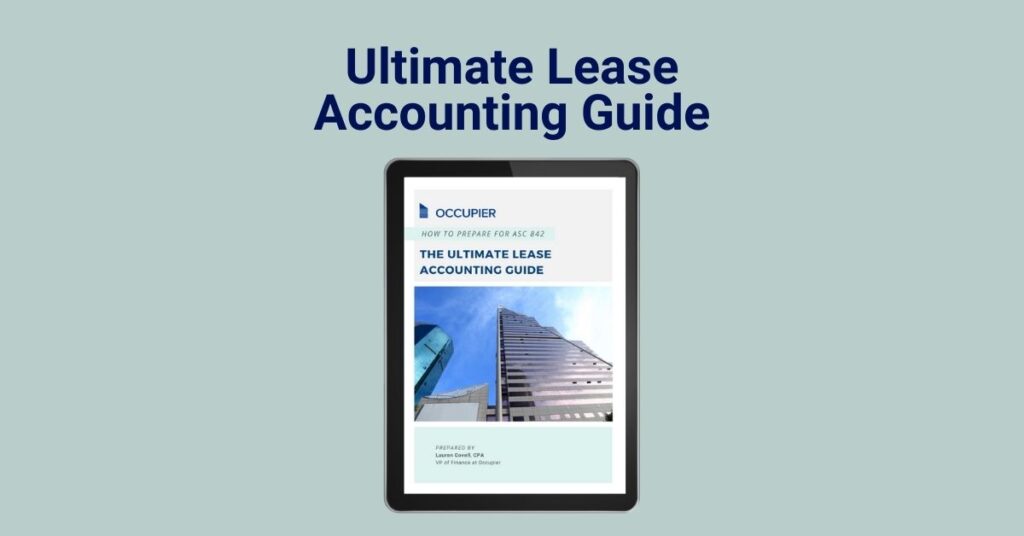What is ASC 842? Lease Accounting Guide
Last Updated on January 12, 2024 by Morgan Beard
Generally accepted accounting practices (GAAP) for lease accounting instituted ASC 842 (replacing ASC 840) in 2019, requiring organizations to record any lease with a lifetime of greater than one year as an asset and a liability on the company balance sheet. The new leasing standard was put forth by the Financial Accounting Standards Board (FASB) to bolster transparency between a company and its investors.
ASC 840 didn’t require operating leases or embedded leases to be recorded as assets reflected on a company balance sheet. The resulting calculations, however, didn’t always portray an accurate financial picture and often portrayed just the opposite, falsely inflating a company’s financial performance.
ASC 842 rectified this error and now all companies that follow GAAP must categorize every lease as both a liability and an ROU, or right-of-use, asset.
What is ASC 842?
ASC 842 creates a significant impact on many companies’ balance sheets. Even if your organization only has one leasing obligation, that must be recorded. Real estate property leases often impact financial statements strongly.
Most companies also lease phone systems, cars, heavy machinery, office equipment, and warehouse space. Then there are more intangible leases, such as services and usage contracts, hidden amongst expenses.
Uncovering every lease a company has and identifying each lease and non-lease components under ASC 842 is rather tedious for businesses, especially if operations aren’t centralized. All in all, accounting for leases under ASC 842 is much more complex than under ASC 840. Financial statement users have a heavy lift to not only make the accounting standards compliance transition but to also build sustainable lease accounting policies and processes for their organization.
Calculating Leases Under ASC 842
Accounting for an operating lease using ASC 840 was simple compared to capital leases. Under ASC 840, operating leases were expensed using a straight-line calculation. Capital leases under ASC 840 were like finance leases under ASC 842 — from the definition to the calculation. Operating lease concepts have one great difference: you must record the net present value of the future payments you’ll make as a liability entry that’s offset by an entry under the ROU asset account.
What if your lease somehow changes? All lease modification change must be accounted for properly, too, with the correct liability and ROU asset entries. For instance, say:
- You’re renting a portion of office space to a tenant and the tenant decides they need more (or less) space than originally leased.
- A vehicle you’re leasing is involved in an accident and sustains damages.
- You’re leasing office equipment and the renter returns it before the lease has ended.
Each of these circumstances requires a revision of your lease entries and, under ASC 842, those revisions might be considered:
- Lease Modifications
- Lease Remeasurements
- Lease Impairments
Each revision classification requires a different calculation for the entries, which can be confusing. If you haven’t yet, it’s time to schedule meetings with your clients to let them know how these changes will affect their accounting going forward.
Who Needs to Comply with ASC 842?
Any organization that follows GAAP and has leases that are longer than one year must comply with all rules recorded in ASC 842. To properly implement ASC 842, companies must change their approach to lease accounting and its financial reporting requirements — on their balance sheet, income statement, and cash flow statements. They also must update the processes involved in accounting for leases. Companies should decide disclosure requirements early in their implementation journey and inspect for organizational accounting relief to ease the transition. Any organization that did not plan for the data updates, financial management changes and system impacts required by ASC 842 might find the changes rather significant and overwhelming — it’s not an overnight implementation.
To make the transition as seamless as possible, it should happen in stages:
- Stage 1: Readiness assessment followed by planning for the change.
- Stage 2: Policy development and selection of storage tools and solutions.
- Stage 3: Abstracting leases and setting up data storage.
- Stage 4: Setting up tools and solutions.
- Stage 5: Deploying plan and monitoring.
While the steps are the same, this may look different for different organizations.
When Did ASC 842 Become Effective?
ASC 842 became effective for all private organizations and nonprofits on December 15, 2021. For the first and all subsequent reporting periods after that date, all private companies and nonprofits must switch to GAAP ASC 842. The original implementation date was earlier than this, but the FASB delayed its rollout due to the global pandemic, offering businesses time to navigate the effects of COVID and properly implement the required changes.For calendar year end, public companies, the transition date was January 1, 2019.
Originally, ASC 842 required all businesses to choose one method of discounting for all lease types. In September 2021, the FASB announced an update to alleviate the undue stress this would cause some organizations. Discount rates are applied to all future payments on a lease and determines the net present value of the lease liability. The update allows organizations to choose one discount rate per asset class. This helps organizations by allowing for an incremental rate for larger leases, such as fleets and office or retail space, which reduces the overall lease liability. The risk-free rate can still be applied to leases that aren’t as material to reports.
Lease Accounting Software Program
To ease this transition now and in the future, the right lease accounting software makes all the difference. For your software to alleviate some of the likely issues posed by transitioning to a new accounting principle, it should:
- Provide efficient calculations. Manually calculating accounting entries is time-consuming, and not all accounting software is made for lease accounting. Lease accounting software ensures your numbers are right, saving you money, time, and headaches down the road.
- Intuitive user experience. Lease accounting software should take the hassle out of implementing ASC 842, not compound your confusion. Search for software with an easy-to-use dashboard and interface to make integration a breeze.
- Offer complete customization. The right lease accounting software for your organization can scale with you, has the features you need and nothing you don’t, and can be modified per your needs.
- Provide absolute security. Speed and accuracy are important in accounting, but secure technology is paramount. Choose a lease accounting software with FASB-level security built in.
- Power the entire lease lifecycle: The Lease accounting changes impact numerous teams from real estate, construction, facilities, and of course, finance and accounting. Choose a software solution that enables collaboration by all stakeholders within the lease lifecycle..
Occupier is the leader in lease accounting software that works and solves the ASC 842 implementation burden on your organization while removing the silos between accounting and real estate teams enabling better collaboration.
Occupier Lease Accounting
Occupier is the top option for lease accounting software under GAAP. Accounting for the changes posed by ASC 842 is easier, more efficient, and more reliable with lease accounting software. We also help manage the international equivalent of ASC 842, call IFRS 16 and instituted by the International Financial Reporting Standards or IFRS group. Both new guidance substantially change the scope of work that the accounting team needs to manage. Reach out to our team to learn more or schedule a demo.
Frequently Asked Questions
How many accounting standards are in ASC?
GAAP provides about 90 accounting principles recognized by the FASB.
What do ASC and US GAAP stand for?
ASC is “accounting standards codification.” GAAP is “generally accepted accounting principles.” The Financial Accounting Standards Board, or FASB, releases, recognizes, and maintains the GAAP standards for the United States.
Are ASC standards mandatory? Do all companies have to implement ASC 842?
Yes. ASC 842 must be implemented by all companies with leases lasting longer than one year. All leases lasting exactly one year, aka short-term leases are not affected by the new standards.
I’ve already transitioned to ASC 842? What can I do to update my internal controls and processes?
Post-audit presents the perfect time to add policies and controls to your lease accounting process. After all, your finance team is undergoing major changes in tracking and managing leased assets.

